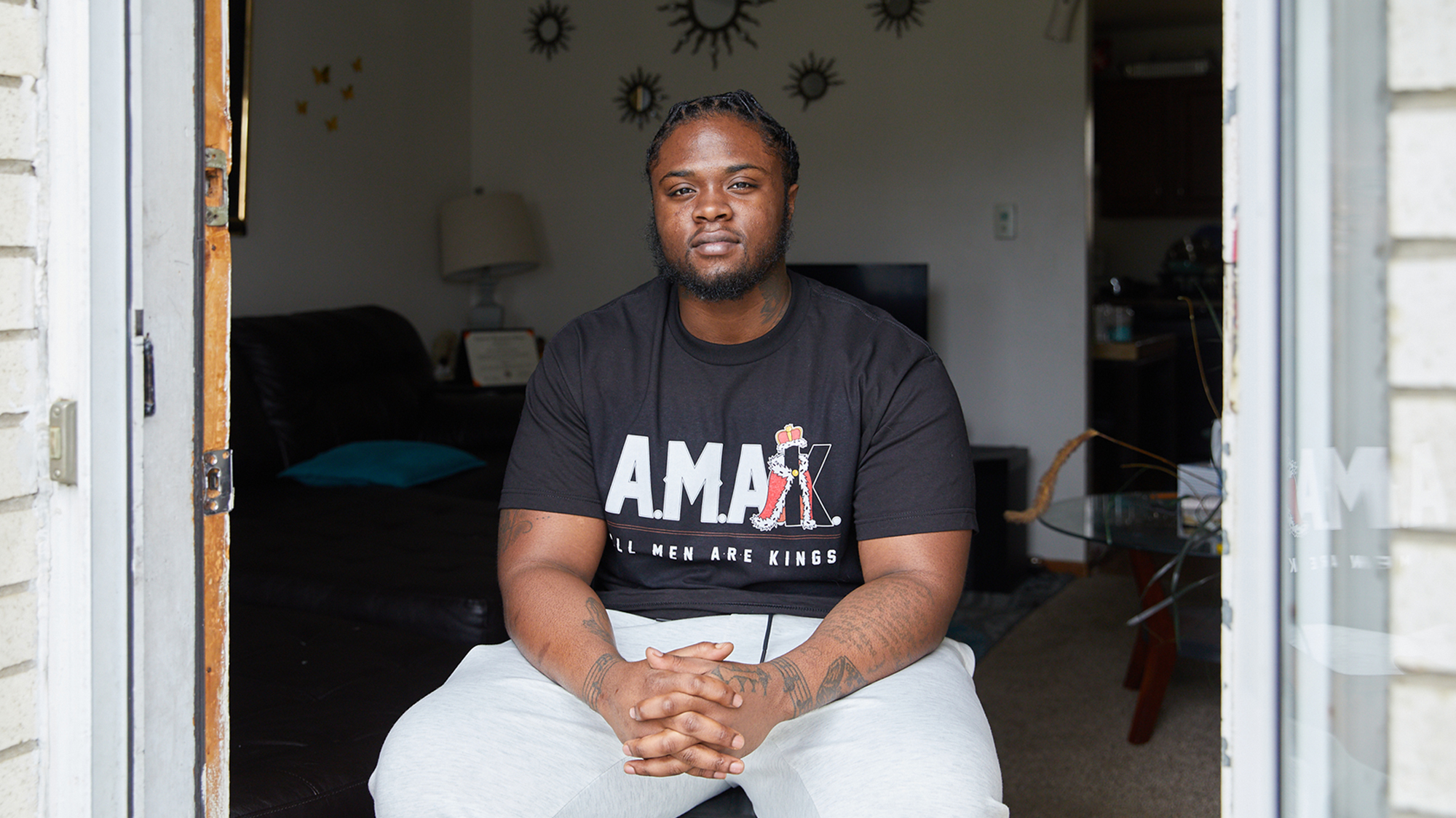This story is published in partnership with Reveal from the Center for Investigative Reporting.
It was Saturday, May 30, just five days after Minneapolis police Officer Derek Chauvin squeezed the final breath out of George Floyd, digging his knee into the back of Floyd’s neck for more than 9 minutes as he cried out in anguish for help. In the midst of a pandemic that had already claimed a disproportionate number of Black lives, people across the country flooded the streets to protest the national epidemic of police violence against Black communities. It wasn’t just Minneapolis and large coastal cities like Los Angeles and New York that rose up in anger, but also smaller, whiter towns, some of them deep inside Trump country. Like the struggling Rust Belt town of Erie, Pennsylvania, a former industrial hub that’s lost nearly two-thirds of its manufacturing jobs and a quarter of its population over the last half-century. In 2016, Donald Trump won Erie County by 2 points.
“Some might call it a little racist town,” said Melquan Barnett, 28, who was born and raised in Erie’s segregated and impoverished east side. He described a childhood marked by witnessing local police target and harass young men of color in a city where 38 percent of the Black population lives below the poverty line. “In my experience, it’s never been a good city for a Black man to be in,” he said.
Watching the video of Floyd’s death sparked a deep well of anger inside him, built up, he said, over years of living in a system designed to protect those who kill unarmed Black people. “As you know, there was many more before George Floyd,” he said. “We’re tired of people being quiet.”
Barnett arrived downtown late that Saturday evening, just as night was falling. A crowd of people was gathered outside the Erie police station, and tensions were rising. Some protesters started banging on the main door. When somebody threw a rock at the window, a SWAT team emerged.
“It was like a movie,” Barnett said, describing police “kitted up like they were about to go to war,” attacking protesters with tear gas and mace. One widely shared video from that night shows police kicking a young white woman who refused an order to disperse.
“You keep pushing somebody, eventually something’s going to happen,” Barnett said. “They’re going to stand up for themselves.”
A few blocks away, Ember+Forge, a high-end coffee shop, occupies the space of a former candle factory. The space and the name both invoke Erie’s lost manufacturing past, as well as owner Hannah Kirby’s vision for helping revitalize the city’s battered economy. The night of the protest, Kirby was at home with her husband and two dogs, hearing about the demonstrations secondhand from one of her employees. “She said it was so beautiful,” Kirby said. “A community coming together. It just felt really, really powerful.”
Kirby, 32, was drifting off to sleep when her employee called again. There was a fire inside the coffee shop, the employee said. People were sharing videos of the fire on social media. Kirby found one shot from the street, so she couldn’t see anyone’s faces. But she could make out an ominous orange glow behind the shattered windows.

Hannah Kirby is the owner of Ember+Forge coffee shop on 400 State Street in downtown Erie.
Da’Shaunae Marisa/Reveal
“Certainly, in that moment, that was gut wrenching, because in my brain, you know, that’s it, right? The building is going to go up!” Kirby said.
Images flashing across her TV screen showed lines of police in riot gear standing at the intersection outside her coffee shop. Local news reports described scenes of chaos with demonstrators throwing fireworks and police deploying tear gas. Kirby panicked as she imagined having to close down for good.
Just after midnight, the city put out a statement on Twitter: “The peaceful protest in downtown Erie has turned into a riot. The situation has escalated, and we are in a state of emergency. Do not go downtown.”
That Saturday night was the first time Barnett had ever gone to a protest. A self-described family man, he used to spend his spare time hanging out with his two sons, 6 and 9; coaching his younger son’s football team; and when he could, he said with a laugh, baking desserts like banana pudding cake and strawberry cake for the elderly ladies in the neighborhood.
Barnett had been working as a forklift operator when he was laid off last year. He’d been looking for similar jobs with little luck, and then COVID-19 struck, and no one was hiring. At the height of the pandemic, on April 12, Barnett’s ex-girlfriend, who was living in Detroit, gave birth to his first daughter. “She was going to be the first lady of the family,” he said, smiling. “The whole family was excited to embrace her and bring her in.”
But less than a month after she was born, before Barnett even had a chance to hold her, his infant daughter died.
Barnett was still reeling from the loss when protests erupted over Floyd’s killing. Watching the collective expressions of grief and outrage in city after city, something shifted inside him, he said. He’d never seen anything like it before, not on television and certainly not in Erie. It left him with an unshakeable feeling that history was being made—and he wanted to be part of it. For the first time in a long time, he felt inspired, even a little hopeful that things might change.
“I wanted to be out there,” he said. “I wanted to be a part of the peaceful protests and creating change, so when 20 years come, I can tell my kids or my grandchildren the stories, and tell them that I was a part of that.”
Two days after Barnett joined the hundreds of thousands of people demanding a change in policing, his mother called him, panicked. The police had come by her house, looking for him. They had a warrant for his arrest.
“The flames went up and then just as quickly, it kind of died down,” she said. “Any damage from our side was very minimal.”Kirby arrived at her coffee shop Sunday morning to assess the damage. She was relieved to count only three broken windows and a charred table top. Security cameras she’d received through the city appeared to show a young woman kicking through the window, a man setting alight a potted plant on a table just inside and, a few minutes later, someone else throwing the plant to the ground and stomping out the fire. She couldn’t really make out anyone’s faces, she said.
Kirby swept up the broken glass and left to get cleaning supplies. When she returned that afternoon, her landlord, who had been boarding up the windows, told her that the police had stopped by and so had someone from the FBI. “I certainly expected our local law enforcement to gather video,” she said, “but I was incredibly surprised that the FBI had come.”
FBI Special Agent Valentino Cuba returned the following day to speak with Kirby. He was with another federal agent, an arson investigator from the Bureau of Alcohol, Tobacco, Firearms, and Explosives, or ATF. Their questions mostly centered on what Kirby considered to be obscure details about her business: Where did she get her plastic to-go cups, and did she sell store gift cards online? At the time, she thought the questions were strange: What did any of this have to do with the fire?
At a City Hall press briefing that same morning, Mayor Joe Schember discussed the damage from Saturday night. The final tally was four fires, four damaged parking meters, nearly two dozen buildings with smashed windows and some spray paint on City Hall. Then Police Chief Dan Spizarny announced that his department had identified a suspect in the Ember+Forge fire: Melquan Barnett.

“I wanted to be a part of the peaceful protests and creating change,” Barnett said.
Da’Shaunae Marisa/Reveal
Two days later, on June 3, defense attorney Charles Sunwabe was at home eating dinner when his phone rang. It was his client Melquan Barnett’s mother: Would he please turn on the news? The US attorney’s office for the Western District of Pennsylvania had just announced a federal arson charge against Barnett for the Ember+Forge fire.
“The First Amendment does not permit people to use a protest as cover to commit arson, destroy property or incite violence,” US Attorney Scott W. Brady said in the press release. “Any protestors who cross this line should know that we will use every tool at our disposal to find you and prosecute you.”
Sunwabe couldn’t believe what he was hearing. Barely four hours had passed since he’d accompanied Barnett to the Erie police station. The Commonwealth of Pennsylvania had charged him with five felonies and a misdemeanor—including two counts of arson, rioting, criminal mischief and risking catastrophe to property—for the coffee shop fire and sent him to the Erie County Prison. Now, just four days after the protest, the federal government had issued a criminal complaint.
“I have never seen any case move this fast in my entire time here in the Western District of Pennsylvania,” Sunwabe said.
Of the 24 people the commonwealth initially charged for the disturbances in Erie on May 30, federal prosecutors took over just two cases: Barnett’s in June and, a few months later, the case of another Black man, Tyvarh Nicholson, who was accused of throwing Molotov cocktails at police. Trials have begun in five of the state’s cases, and in each one, the initial felony charges were downgraded in court to misdemeanors and citations for more standard protest charges such as criminal mischief and failure to disperse.
Federal courts offer much less room for discretion. Like many federal crimes, arson comes with a mandatory minimum sentence, regardless of the scale of the damage. If Barnett were found guilty, he would face imprisonment for five to 20 years. “The United States does not joke around,” Sunwabe said.
Barnett was in his cell when he found out that the state had dropped his case and the federal government was picking it up. He, too, learned it on the news, from a television set angled high on the wall. “I’m just sitting there thinking, man, this is going to get darker and darker.”
Five days later at Barnett’s detention hearing, Magistrate Judge Richard Lanzillo agreed with Assistant US Attorney Christian Trabold’s argument that Barnett was a danger to society because the tabletop fire he was accused of lighting could have endangered people living in apartments above the coffee shop. Lanzillo said he had a “very hard time accepting the characterization of this crime as anything less than very serious.” Arson, he pointed out, “threatens both life and property.” Barnett’s case had become part of an aggressive campaign by the Trump administration’s Department of Justice to go after Black Lives Matter protesters nationwide, using a tenuous legal rationale to pursue dozens of cases related to arson, theft or property damage.
Barnett was denied bond. He remained in the Erie County Prison for the remainder of the summer as the pandemic raged on.
Agents from the FBI and ATF learned about the fire at Ember+Forge by watching videos posted on social media from the protests in Erie that night. “That’s where we got a lot of our information from,” said Deputy Police Chief Mike Nolan, “and the FBI also saw some of that activity and contacted us.”
The FBI asked the Erie police about a couple of incidents officials had seen on video that “met their criteria” and said the agency would be willing to consider taking on cases of arson and anything involving an incendiary device, Nolan said. He didn’t know what the FBI’s criteria were, noting that “it changes based on what their priorities are at that given time.” Nolan said that the Erie police had a “strong relationship” with their federal partners but that his department had no say in which cases federal prosecutors took on.
According to the criminal complaint against Barnett, Cuba, the FBI agent, matched the clothing and hair of the man seen lighting the fire in the Facebook Live video Kirby saw to other videos from that night posted on social media that allegedly show Barnett wearing the same clothes.
The complaint also laid out why federal prosecutors had standing: Ember+Forge is a business that engages in “interstate commerce.” As proof, Cuba’s affidavit pointed out that Hannah Kirby sources her coffee cups from a small company in Buffalo, New York; that she sells Ember+Forge gift cards online; and that the shop has an online presence.
Kirby said she was speechless when she heard the news. “We are really as local as we can be,” she said. “To be labeled an interstate business that really only does business within a few miles’ radius is really frustrating when it’s being used punitively against somebody. This is not the justice I am seeking.”
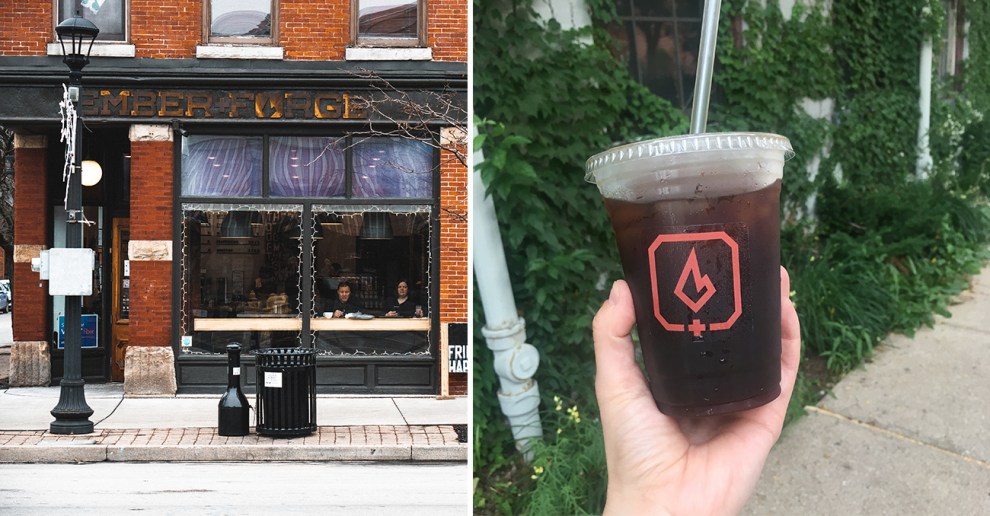
Left: Ember+Forge, in downtown Erie, before the fire and the pandemic. Right: The coffee shop’s plastic to-go cup purchased in Buffalo, New York, that gave prosecutors standing to pursue a federal arson case.
Matthew Giesting/Courtesy of Ember+Forge
Kirby remains incredulous that Barnett is facing a federal felony charge for what she considers minimal damage. Her landlord replaced the windows, a cost she says was covered by his insurance, and a local woodworker offered to paint around the burn marks on the table and turn it into a piece of art. The FBI declined to comment, referring Reveal from the Center for Investigative Reporting to the US attorney’s office. Brady’s office sent Reveal an emailed statement saying it would “continue to partner with the FBI, ATF, and the Erie Police Department to aggressively investigate and prosecute violent crime committed under the guise of protest.”
“In what world is a human life worth less than anything?” she asked. “We’re going to value 10 years of his life at less than a window or less than a tabletop that got charred?”
Barnett is one of over 340 people in at least 31 states facing federal charges coming out of the historic wave of Black Lives Matter protests over the summer. An analysis of the 319 unsealed charges by Reveal shows that Barnett’s case is hardly atypical: The majority of the charges concern arson, theft or property damage.
The message to make federal cases out of protest-related vandalism came straight from Trump and the country’s top law enforcement official, US Attorney General William Barr. And it came fast.
At first, the president called George Floyd’s killing in Minneapolis a “very, very sad event” and promised that “justice will be served.”
But by the third night of protests, Trump had taken to Twitter to call protesters “THUGS” and threaten military force. “When the looting starts, the shooting starts,” he tweeted, parroting the infamous threat from a Florida police chief during the tumultuous civil rights era.
The following Monday, June 1, after a weekend of more than 1,200 protests, Trump held a conference call with the nation’s governors during which he painted a picture of anarchy spreading across the country. He falsely claimed that all the storefronts in Los Angeles were gone and claimed that crowds had broken into stores in Philadelphia and “nobody showed up to stop them.”
“These are terrorists. They’re looking to do bad things to our country,” he told the governors.
“We’re going to clamp down very, very strong,” he added, “but you’ve got to arrest people. You have to try people. You have to put them in jail for 10 years.”
Barr, who was also on the call, said the FBI and Justice Department would work directly with local and state law enforcement to build these cases “to go after the troublemakers, to go after the guys who were pounding the bricks and the Molotov cocktails.”
“We want to lean forward and charge federally anyone who violates a federal law in connection with this rioting,” he said.
The protests were overwhelmingly peaceful. An analysis by the Crowd Counting Consortium, a collaboration led by scholars at Harvard’s Kennedy School and the University of Connecticut, found that no injuries were recorded during 97.7 percent of some 7,500 demonstrations that roiled the nation during the first month after George Floyd’s murder. Only 3.7 percent involved property damage, including arson and vandalism. Police were injured by protesters in just over 1 percent of them.
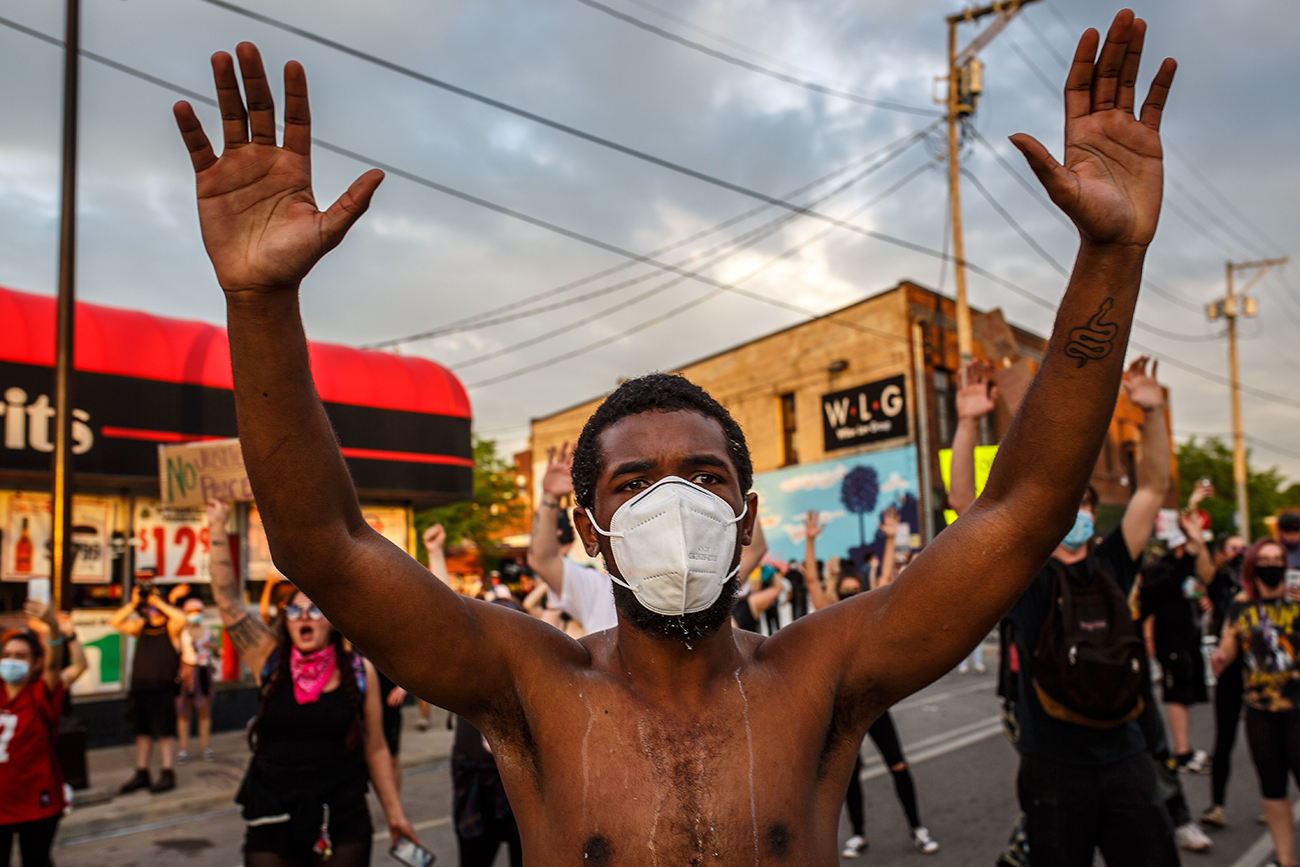
A protester raises his hands during a demonstration over the killing of George Floyd on May 27 in Minneapolis.
Kerem Yucel/AFP/Getty
Yet within roughly two weeks, prosecutors from 36 US attorney’s offices from Brooklyn to San Diego had charged and taken into federal custody 105 individuals for alleged crimes committed just during the first weekend of protests. Among their number was Melquan Barnett.
While two of the cases related to the killing of a federal officer by members of the far-right Boogaloo movement and four related to minor injuries to police, more than two-thirds of the cases related to theft, arson, property damage or the threat of property damage. These federal crimes included the robbery of a CVS and the looting of a liquor store. They included tossing a Molotov cocktail at an abandoned police car, hurling bricks at a police vehicle and spray-painting the words “Y’all not tired yet?” on the Lincoln Memorial. And they included posting messages on Snapchat and Facebook calling for rioting and looting.
Barbara McQuade, former US attorney for the Eastern District of Michigan, said, “Federal resources are scarce and get used for major priorities like international terrorism, massive fraud and drug trafficking with Mexican cartels—you know, massive cases.” Many of these protest cases struck her as “very small potatoes” unworthy of federal resources. But she said they speak to a national federal priority set by the attorney general.
In Erie, it took federal agents four days to go through video footage, establish that Kirby’s coffee shop was an interstate business and draw up the criminal complaint against Barnett. In St. Louis, federal investigators moved even faster.
On the morning of Sunday, May 31, in the midst of that first weekend of national protests, Michael Avery was standing outside his house in Jennings, Missouri, a majority-Black suburb of St. Louis that borders Ferguson. The 29-year-old community activist had returned home from Minneapolis the previous night. He said he had gone to connect with other activists, livestream the protests and share what he learned over Facebook. Avery was with his 3-year-old daughter and his mother, getting ready to wash her car on their quiet cul-de-sac, when a line of vehicles pulled up. Several uniformed men emerged, and Avery said he figured they were coming for him because of his activism. They wanted to “shut me up permanently,” he said.
Avery has been protesting police shootings since the night after Michael Brown was killed in Ferguson on Aug. 9, 2014. Since then, he’s become known locally for his vocal opposition to police violence and as a Black man who openly carries a gun in an open carry state. Avery said he needs the gun for his volunteer work: He’s the driving force behind a group called Bring Them Home Search and Rescue, which helps locate missing people in parts of St. Louis with rising homicide rates. Avery carries his weapon at protests, too, and posts those images on Facebook.
Avery started livestreaming his arrest as it was underway. In the video, you can hear him asking for paperwork as the camera settles on an officer’s uniform. A male voice responds, “You don’t have to see paperwork, it’s been signed.” Avery asks if he can hand his phone to his mother as he is handcuffed, and just before the officer asks his mother to turn off the phone, you can hear Avery saying, “All I did was voice my opinion.”
The affidavit against Avery, signed by FBI Special Agent Ryan Monahan, notes that Monahan and other investigators had been monitoring social media activity for “evidence of imminent acts of violence” when they came across Avery’s Facebook page, where Avery had been posting live video feeds from Minneapolis. In one of his many posts, Avery called on activists in St. Louis to be available for a “level red action” on Saturday night: “Calling out all the shooters, all the people who don’t give AF. All the people who has had enough.” On his way home, Avery posted a long video describing how young people in Minneapolis had carefully targeted the looting, marking off Black-owned businesses “that were not to be touched under no circumstances.” That Saturday night in Ferguson, as in Erie, a crowd gathered outside the local police station. Protesters smashed windows and threw rocks and bottles at police, according to the federal complaint. As these events were unfolding, Avery posted a call on Facebook: “Red Alert everyone get to Ferguson PD right now.”
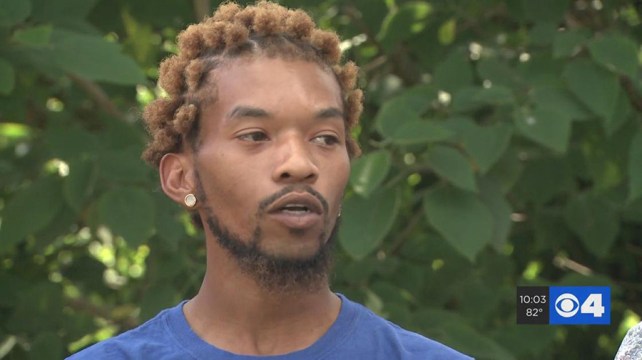
Video still of Michael Avery from a television interview
Assistant US Attorney Michael Reilly argued in court that Avery was a “leader” of protest movements in St. Louis and suggested that his posts on Facebook had incited violence, rioting and somehow even the killing of a police officer in a pawnshop several days later, while he was being held in the county jail—a claim Magistrate Judge Patricia Cohen shot down as “a stretch.” Stating that the FBI had assessed “a level red action to be associated with a high level of violence,” Monahan accused Avery of looting in Minnesota and providing “tutelage” to St. Louis activists, encouraging them to do the same. Avery was charged with using the internet, a “facility of interstate commerce,” to incite a riot. He was accused of violating a law pushed by segregationists as an amendment to the Civil Rights Act and most famously used against the Chicago Seven in 1968.
“His posts do carry weight,” Reilly insisted. “I know he was in custody, Judge, but it’s possible to incite people and then, once they’re incited, they’re incited.”
Two and a half weeks later, on June 17, the US attorney for the Eastern District of Missouri dismissed the complaint against Avery. The case had collapsed.
Javad Khazaeli, who worked terrorism cases for over a decade at the Department of Justice and Department of Homeland Security, is now an immigration attorney in St. Louis and followed Avery’s case closely. “My one-word response as a former prosecutor with the federal government is ‘embarrassing,’ ” he said of the government’s case against Avery. “Look at the timeline and how quickly they came down with these charges—there was no due diligence done.”
At Avery’s pretrial detention hearing on June 3, the government’s attorney argued that Avery “traveled from out of state for the sole purpose” to incite a riot and “had no community ties of any kind to St. Louis.” “A simple Google search would have proved that was wrong,” Khazaeli said. Avery describes himself as a radical activist. But he grew up on the south side of St. Louis and runs a lawn care business in Jennings.
Three longtime organizers who train activists in civil disobedience sent letters to the judge in support of Avery, explaining that among activists, a “level red action” indicates a high risk of arrest and a greater likelihood of police violence. “Red does not refer to violence or destruction being done by protestors,” wrote one of them, Lisa Fithian.
Avery was shaken by his time in jail and the federal charges against him. But the experience also woke him up to something. “They feel like my voice is strong enough to get more people on the streets,” he said of the federal government. “That motivates me to continue my work and take it to another level.”
The US attorney’s office that brought the case against Avery would not comment on his case but said the office had charged a total of 12 people connected to the protests, cases that all “remain pending.”
So far, federal prosecutors across the country have had to drop charges in at least nine cases, including Avery’s.
In Avery’s case, in Barnett’s and in about half of the federal cases coming out of the Black Lives Matter protests, charges are grounded in the commerce clause, a constitutional principle that gives Congress the power to regulate international and interstate commerce. It also allows federal prosecutors to pursue criminal charges if a crime involves interstate commerce. Until this past summer, conservatives, including Barr, had long opposed its use, as it has undergirded a range of policies that Republicans have opposed, from labor protections during the New Deal to bans on segregation during the civil rights era and the Affordable Care Act.
Federalizing protest-related prosecutions at this scale is “extraordinary,” said Jonathan Smith, a former Justice Department lawyer who now leads the Washington Lawyers’ Committee for Civil Rights and Urban Affairs. Typically, incidents like these are left to local authorities to prosecute; the protests against the World Trade Organization in the 1990s and the Occupy movement in the 2000s resulted in mass arrests, but they were handled locally. The federal government typically gets involved only if there’s a high federal interest and local officials are incapable of addressing it or unwilling to do so, Smith said.
The only real precedent also came under Trump: the decision by federal prosecutors to charge 234 people, including medics, journalists and legal observers, with felony rioting out of the Washington, D.C., protests on Trump’s Inauguration Day in January 2017. “It was shocking at the time and felt like a signal of things to come,” Smith said. Within a year and a half, the vast majority of those charges had been dropped.
Kristy Parker, another former Justice Department lawyer, described many of this past summer’s prosecutions as “broken-windows policing on a federal level.” She said it would be “impossible” not to call this a “very aggressive use of federal law enforcement powers.”
Certainly, the federal involvement has ruffled the feathers of some local prosecutors. In Portland, Oregon, Multnomah County District Attorney Mike Schmidt issued an official policy in August declining to prosecute cases relating “solely to protest activities,” including charges of rioting, disorderly conduct and interfering with officers. Calling such prosecutions a drain on “crucially needed resources,” Schmidt rejected nearly 70 percent of the 1,000 or so cases referred to his office by police. Meanwhile, federal prosecutors in Oregon have brought at least 97 cases against Portland demonstrators—constituting nearly a third of protest-related federal prosecutions nationwide—many of them for the very crimes the local prosecutor had refused to charge.
In Pittsburgh, US Attorney Scott Brady filed charges against 11 protesters for damaging police cars and throwing projectiles at the police—after District Attorney Stephen Zappala already had filed state charges against all of them. Zappala spokesperson Mike Manko said it was “unclear” why the US attorney would want to focus on “local protest cases.”
St. Louis Circuit Attorney Kim Gardner said there was no reason for federal prosecutors to “inject” themselves into cases of arson or property damage that local prosecutors could easily bring themselves. She said she views the federal prosecutions—in light of Trump and Barr’s law-and-order rhetoric—as a form of political intervention into local Democratic jurisdictions. They are “attacking prosecutors who believe in alternatives and holding Black and white people accountable, as well as police officers,” she said.
When her office filed felony charges against Mark and Patricia McCloskey, a white St. Louis couple who aimed their guns at peaceful demonstrators marching through their privately owned neighborhood over the summer, Gardner found herself in the middle of a political firestorm. Trump described the charges as a “disgrace” and his chief of staff, Mark Meadows, invited the McCloskeys to speak at the Republican National Convention.
As Black Lives Matter protests continued into late June, Barr created a task force to combat “violent anti-government extremists,” a designation that includes supporters of the far-right Boogaloo Bois as well as antifa, the loosely organized movement of anti-fascist activists. These individuals, Barr said in a departmentwide memo, may “pretend to profess a message of freedom and progress, but they are in fact forces of anarchy, destruction, and coercion.”
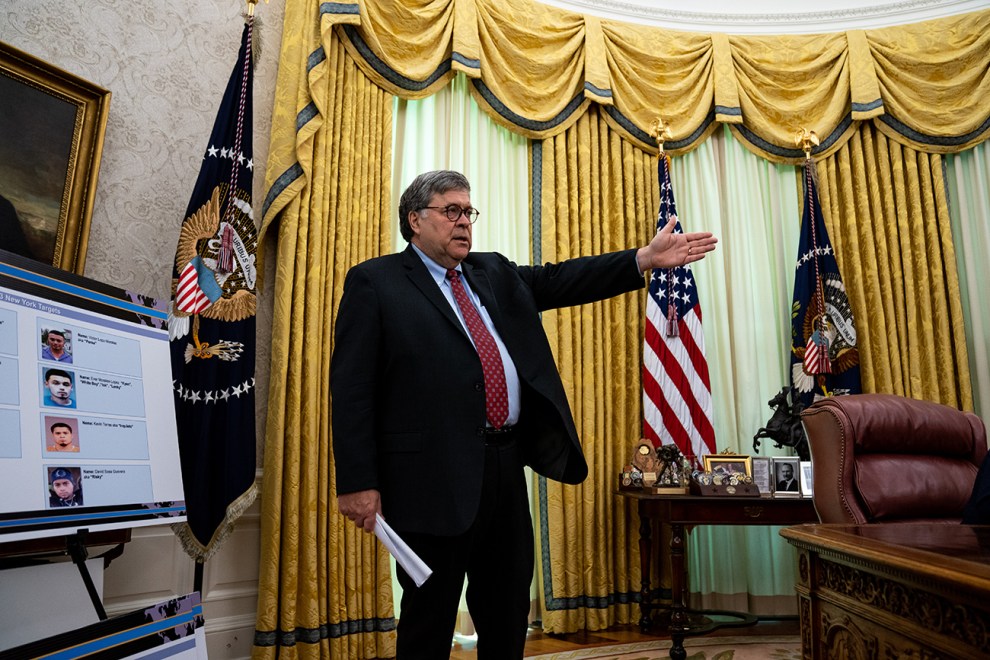
Attorney General William Barr addresses President Donald Trump (not shown) in the Oval Office on July 15.
Anna Moneymaker-Pool/Getty
Of the 319 unsealed cases the Justice Department has brought against protesters, only one, against a Rochester, New York, activist accused of inciting a riot, alleges a connection to antifa. Six involve members of the Boogaloo movement.
What is striking is how few of the unsealed cases involve allegations of bodily harm. Two individuals affiliated with the Boogaloo movement were charged with murder and attempted murder for fatally shooting one federal officer and wounding a second in Oakland, California, during protests May 29. And while 58 protesters in Portland and 16 in other cities were charged with hitting police or federal officers with such objects as explosives, water bottles, a skateboard and a beer can, officer injuries are alleged in only nine of these cases.
Of the 101 arson cases, only three involved injuries—in two cases to the arsonists themselves and in the third to a Pennsylvania state trooper. There are only indications in five other cases, including Barnett’s, that the fires involved buildings where people were present. Half of the arson charges relate to fires set in empty police cars.
As Barr’s Justice Department pours resources into building relatively simple cases against those protesting police violence for property crimes such as looting, arson and vandalism, it has not made public a single investigation into the wave of excessive force levied against protesters—the eyes shot out, the cracked skulls—by police over the summer or into systematic civil rights abuses by police departments where officers have been accused of high-profile killings.
In fact, the administration’s obsession with property damage has an ugly corollary: a tendency to prosecute those responsible for damaging cars and buildings more aggressively than those responsible for destroying Black lives.
Federal prosecutors and the FBI have initiated criminal probes into the murders of George Floyd in Minneapolis and Breonna Taylor in Louisville, Kentucky, and the shooting of Jacob Blake in Kenosha, Wisconsin, but Smith, the former Justice Department attorney, said investigating the conduct of individual officers is not enough.
“There are serious and deep problems in those departments that cannot be addressed through accountability for those individual officers, but need a fundamental and structural change in those departments,” he said. In the recent past, the Justice Department was a factor in driving that change forward through suing departments and then negotiating consent decrees in court.
When he was head of special litigation for the Justice Department’s Civil Rights Division, Smith led the civil probe into the Ferguson Police Department, which began soon after the protests following the police killing of Michael Brown. “You could not have a greater contrast than what happened in 2014 and what’s happening in 2020,” Smith said.
During President Barack Obama’s second term, Smith’s section led similar “pattern or practice” investigations into 14 other police departments over civil rights abuses, including in Baltimore after the in-custody death of Freddie Gray in 2015 and in Chicago after the fatal shooting of Laquan McDonald in 2014. In Trump’s nearly four years in office, the section has investigated only one, in Springfield, Massachusetts.
In Erie, local activists and national civil rights groups tried for years to get the Justice Department to investigate systematic civil rights abuses by the police there. Then, in July 2016, the Justice Department opened a criminal investigation into the arrest of Montrice Bolden, who suffered facial fractures and a concussion during his arrest by Erie police. But just two months after Jeff Sessions took office as attorney general, the Justice Department closed the investigation, announcing it would not bring civil rights charges against any members of the Erie police.
The administration’s focus on acts of violence by protesters has also meant turning a blind eye to widespread violence committed by police during the demonstrations. Amnesty International documented 125 cases of excessive force against demonstrators, while data from the nonprofit Armed Conflict Location and Event Data Project suggests law enforcement used force against demonstrators in 460—or nearly 1 in 20—Black Lives Matter protests. Citizen groups, using videos posted on social media, have documented many hundreds of other instances of police violence directed at protesters. In many cities, researchers from the Crowd Counting Consortium note, it was excessive force by police—the use of tear gas, pepper spray and batons; pushing into crowds on horses or in vehicles—that turned protests violent.
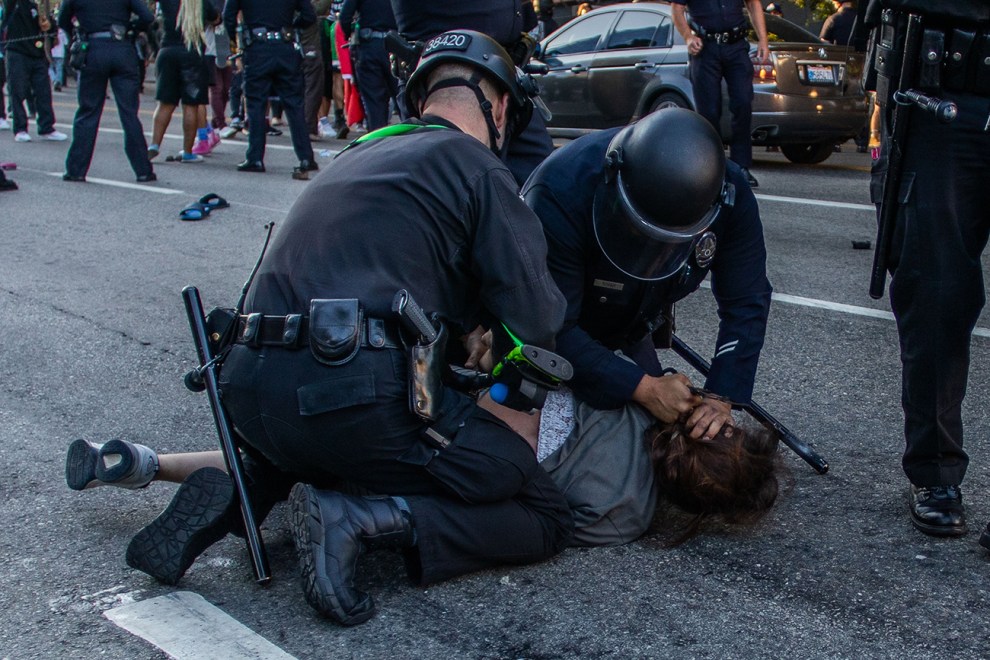
Police officers arrest Lorises Tercero in front of the US courthouse in downtown Los Angeles during a July 25 protest demanding justice for George Floyd and Breonna Taylor.
Apu Gomes/AFP/Getty
Instead, at a gathering of police chiefs Oct. 16, Barr doubled down on his law-and-order message. He claimed that excessive use of force by police officers is “relatively rare and becoming rarer” and said “there is no valid justification for physically resisting a police officer. The approach must be ‘comply first, complain later.’ ” Smith noted that the Justice Department hasn’t opened a single investigation into excessive force by police this year. “This administration has made clear its view that it is not going to hold police accountable to their constitutional obligations,” he said.
“These are the radicals who have hijacked demonstrations,” he said of those protesting police violence. “These are not peaceful protesters exercising their First Amendment rights. They are criminals and thugs and must be dealt with accordingly.”
“This wasn’t a dog whistle,” said Phillip Halpern, former assistant US attorney for the Southern District of California, who publicly resigned in October after 36 years as a federal prosecutor. “This is the attorney general making crystal clear he wants more prosecutions for protesters.”
In pursuing federal charges against the Black Lives Matter movement, the Justice Department is effectively seeking higher penalties for protesters than for others engaging in the same conduct. Smith calls this “chilling” because it implies the department is punishing people for their speech.
“It’s because it happened in the context of demonstrations against police brutality and racism that the government has gotten involved, not because there’s something about these particular crimes,” he said.
Halpern, too, said these prosecutions trouble him greatly. “It augurs a widespread federalization of potential criminal activity in pursuit of a political agenda,” he said.

Portland police disperse a crowd on September 23, 2020. Violent protests erupted across the nation Wednesday following the results of a grand jury investigation into the police shooting death of Breonna Taylor. (Photo by Nathan Howard/Getty)
Together with the tear-gassing of demonstrators in front of the White House on June 1, the militarized response to protests in Portland since early July and Trump’s repeated threats of military intervention to quell protests in Democrat-run cities, the prosecutions are a part of the largest federal crackdown on mass protests in recent memory.On his call with governors on June 1, the president compared the protests to Occupy Wall Street and made what might be his clearest statement yet about what was driving his demand for a tough federal response. “It’s a movement,” he said, “that if you don’t put it down, it will get worse and worse.”
The last time a president sent federal troops to an American city was in 1992, when President George H.W. Bush invoked the Insurrection Act during the outburst of popular anger in the aftermath of the Rodney King verdict and sent 8,200 federal troops to Los Angeles. His attorney general at the time also happened to be William Barr.
In Erie, Melquan Barnett pleaded not guilty and rejected a plea offer. His application for release from pretrial detention was accepted on the last day of August, after he’d sat in jail for three months. US Attorney Scott Brady opposed his release, calling him a “drug-using arsonist with mental health issues and a significant criminal history” who posed a threat to society. A new judge, Susan Baxter, granted Barnett bail.
By Barnett’s telling, much of his criminal record is inseparable from what it means to be a young Black man in a place like Erie. His rap sheet includes several charges that stemmed from the countless times he’d been stopped by police since he was old enough to drive—showing false identification, driving with a suspended license and possession of small amounts of drugs. “You cannot call that significant,” said Charles Sunwabe, Barnett’s lawyer. “None of these are serious crimes.”
Barnett’s release is predicated on the condition that he remain under the strictest form of home incarceration; he is not allowed out of his mother’s house except for medical emergencies or court appearances. Barnett said it’s better than being in jail. But he can’t sit on his front porch to catch a moment of sunlight. And the devoted coach can’t step into his backyard to kick a ball around when his son visits. “That kills me, man,” he said.
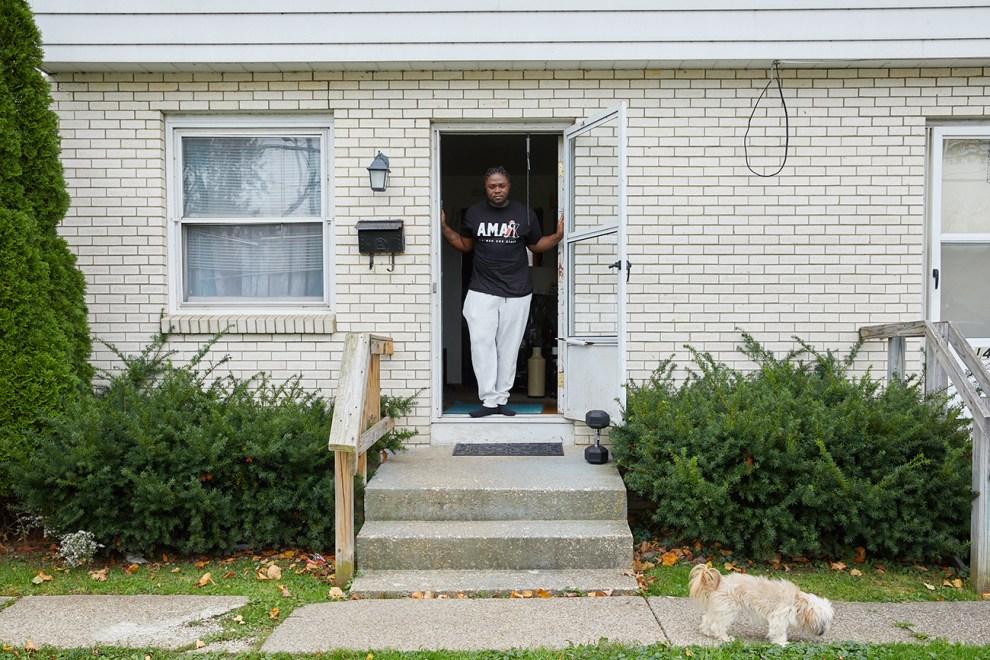
Melquan Barnett at home in Erie, PA.
Da’Shaunae Marisa/Reveal
Now, after spending three months in jail, he’s facing down a tough court battle against some of the nation’s top prosecutors and the prospect of spending several years in prison. “Going through what I’m going through has snatched that all out of me,” he said. Barnett said his experiences this past summer have soured his views on protesting and deepened his cynicism about the police. “At the beginning, I was lit up with joy and happiness and inspired,” he said, by the sheer scale and raw energy of the protests over the murder of George Floyd.
“These are political charges that the government is bringing,” Sunwabe said. “They’re trying to make an example of people like Melquan, to silence people so they never get back on the streets.”
Reveal reporter/producer Stan Alcorn contributed to this story.
Anjali Kamat can be reached at akamat@revealnews.org. Follow her on Twitter: @anjucomet.
